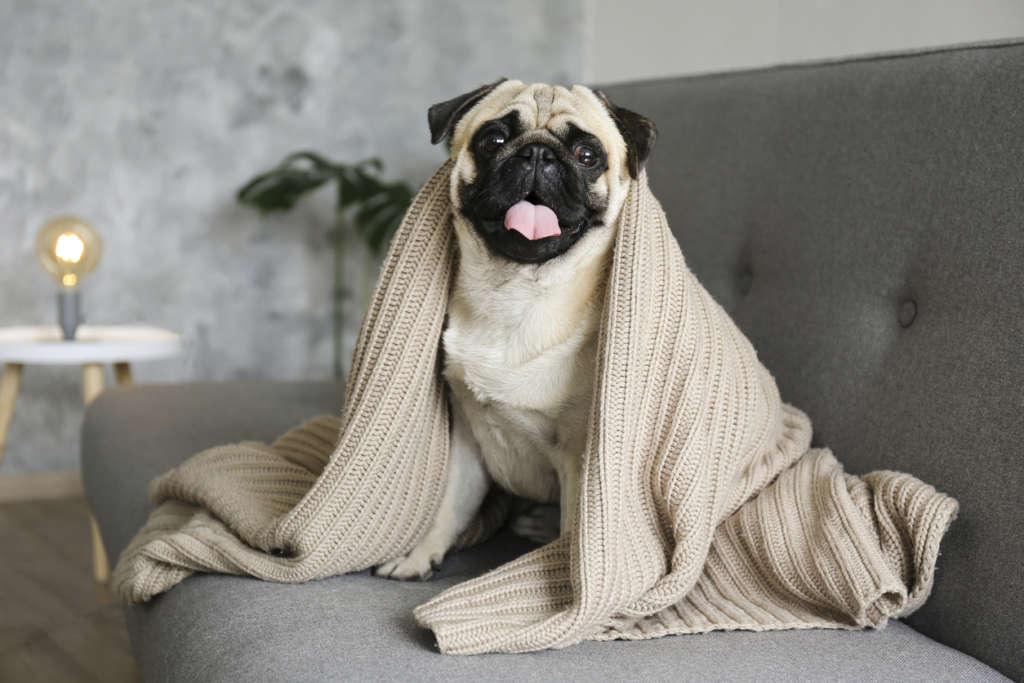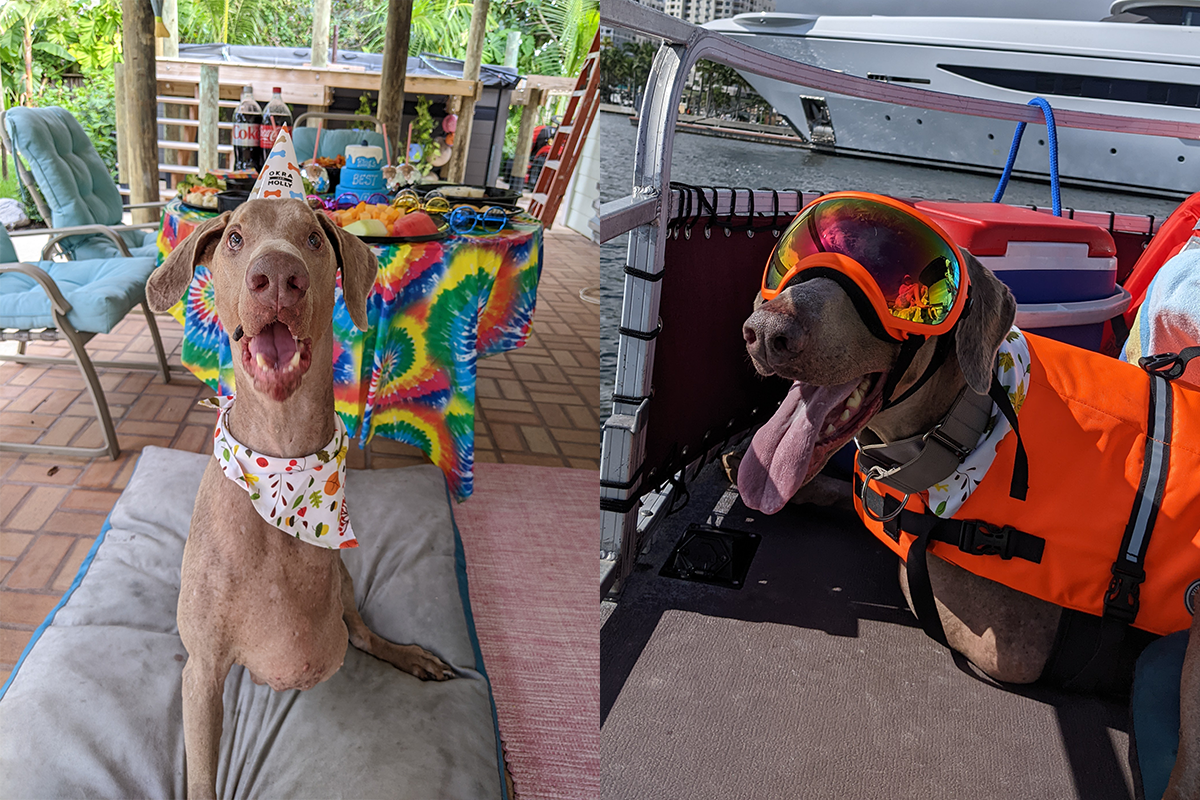Among the smaller dog breeds, the pug dog is just as iconic as Pomeranians and Chihuahuas. A member of the toy dog group, the playful pug lives up to its classification. With a short, curly tail and an even shorter snout, pugs are one of the most instantly recognizable breeds.


These roly-poly rascals are mischievous little creatures with hearts of gold. Equal parts goofy and proud, the pug gives and receives love like no other. If you’re looking for a house dog, you’ve found it in the perfect little package.
Breed Overview
Pugs Are Also Known As…
Dutch bulldog, pug dog. Puggles. “The dog that sniffles up a storm.”
What Is The History Of The Pug?
Like the Shih Tzu and the Pekingese, the history of the pug begins in Imperial China. Bred as companions for Chinese royalty, pugs have a regal side to them—a side you can still see today.
The pug dog breed made its way from Asia to Europe in the late 1500s, when Dutch traders brought them back home on the high seas. Ever comfortable on the laps of royal families, the pug dogs quickly became a favorite of the Dutch court (thus the alternative name of “Dutch bulldog”).
Once one aristocratic family had a pug, everyone had to have this adorable dog. From England to Italy and everywhere in between, pugs became the pup du jour for monarchs like King William III. After taking over Europe, the pug set its sights on new horizons: the promising shores of the U.S.A.
The first pug was registered in America in 1885. The American Kennel Club officially recognized it in 1931. From there, the breed’s popularity ebbed and flowed with the times. Today, pugs aren’t exactly “top dogs,” though they still rank in the top 30—but those who love them will live and die by their smush-faced friends.


How Big Do Pugs Get?
Pugs are known for their bulky bodies and shorter legs. It’s what makes them super adorable, especially when they run. The average-sized pug is typically:
Height: 10–13 inches
Weight: 13–19 pounds
How Long Do Pugs (Generally) Live?
On average, a healthy pug can live 13–15 years. However, there have been reported cases of pugs living much, much longer. According to the Guinness Book of World Records, one of the oldest dogs ever was a pug named Snookie—she almost made it to 28 years old!
What Is A Pug’s Temperament & Personality Like?
Pugs are chill, charming, and total sweethearts. If you show even an ounce of affection to one of these pups, you’ll receive a ton in return—no matter who you are. From aunts and uncles to delivery drivers and even unwanted solicitors, anyone is a worthy target of a pug puppy’s love.
One of the ways this little dog shows its fondness for you is through play. While they may not be the most athletic of animals, they more than make up for any physical shortcomings through sheer moxie.
Good With Kids? Cats? Dogs?
Kids love pugs, and pugs love kids—it’s as simple as that. As long as a child is gentle and respectful around your pint-sized pooch, you won’t need to worry. To be safe, always supervise young children around dogs, especially if they’ve had minimal canine exposure.
Like kids, cats are favored among pugs. They’re usually an ideal match because the two are similar in size. Don’t be surprised to come home and find your pug puppy curled up with your normally naughty tabby.
And the good news keeps on coming: pugs are friendly little fellows around other dogs, even ones they’ve just met. They’ll try to hold their own among canines twice their size (and often, they’ll succeed).


Are Pugs High Energy?
Your average pug has a moderate amount of energy. They won’t bounce off the walls, but they’re usually up for more than lazing on the couch all day (keyword: usually). Sometimes, all a pug wants to do is nap. They’re also happy to chase the ball around in the yard or go for a mid-morning stroll.
It’s worth mentioning that even if your pug is of the rambunctious sort, they—and more importantly, you—need to be cautious in warmer weather. A pug’s short face can cause breathing problems. Pair that with strenuous exercise and high humidity, and you can understand why it’s better to stay inside the air-conditioned apartment to beat the summer heat.
Speaking of apartments, condo dwellers will be glad to know that pugs don’t let their energy out vocally. Unless startled or upset, the pug is quite a quiet canine.
Are Pugs Hard To Train?
Pugs have a (somewhat deserved) reputation for being headstrong. While it’s easy enough to go through obedience training with a pug, you may need more patience here than with other dogs. The earlier in puppyhood you teach obedience and tricks, the better.
With all of that said, pugs are nothing if not affectionate. And what better way to show their love for you than heed your every word? Pugs aim to please, so they’ll generally listen when you give commands.


Do Pugs Have Health Issues?
Pugs are prone to a handful of conditions and afflictions. While many of these health problems are rare and/or treatable, you’ll still need to watch for issues with your pugs:
- Eyes – Partly because of their face shape, pugs sometimes deal with eye health problems. These include dry eye (pigmentary keratopathy), bulging eyes (proptosis), and eyelids and lashes that grow toward the eye (entropion and distichia, respectively).
- Joints – Between hip dysplasia (issues with the hip joint) and luxating patellas (dislocating kneecaps), pugs don’t have the best track record for bone and joint health problems. Aside from pugs, other breeds prone to hip dysplasia include Rottweilers and Bernese mountain dogs.
Finally, one of the most common—and substantial—issues in pugs is BOAS (brachycephalic obstructive airway syndrome). This respiratory condition comes from the “squished-in” face shape that gives pugs their signature appearance.
More recently, however, there’s been a movement of breeding away from the telltale short snout and flat pug face. The goal? Making pug health problems a thing of the past.
Do Pugs Shed?
A sincere apology black pants and clean couch lovers: pugs are notorious shedders. Despite being a small dog, pugs leave a sizable trail of fine, smooth hair in their wake. Thankfully, weekly brushings can take off most loose hair, giving your dark-colored clothes a fighting chance.


How Much Does It Cost To Care For A Pug?
With so many variables at play, it’s never easy to estimate dog ownership costs. Where you live, your pup’s needs, and how consistently you give in to the temptation to spoil your pug rotten can all cause your expenses to fluctuate.
To stay on the safe side, you should budget at least $1,100 per year to keep your pug happy, healthy, and at least a teeny bit spoiled.
Dog Food
You might think that a short little pug can’t pack away too much food (and you’d be wrong). Although they should eat between 1 and 1.5 cups of dry food per day, they’ll gladly eat more.
Seriously, pugs love to eat (and really, who can blame them?), so they’re more susceptible to canine obesity. Keep an eye on your pup’s kibble consumption, encourage them to exercise, and you won’t need to put them on a doggy diet. When feeding your pug the appropriate amount, you can expect to spend around $30–60/month on food.
Ready to take the guesswork out of feeding your furry friend? BARK Eats makes personalized food for your pug! All you have to do is enter your pet’s age, weight, and dietary needs, and they’ll send you a portioned bag of high-quality food every month. Try it out and get 50% off your first month!
Routine Vet Care (Healthy Dog)
Like their human caretakers, dogs benefit immensely from routine checkups—even when they’re in seemingly perfect health. Because pugs are prone to various afflictions, bi-annual trips to the vet are a must.
A routine vet visit for a healthy pug should cost between $50 and $60. Add a handful of other medical expenses into the mix, and your total annual vet costs should come to about $200–250 per year.
Preventative Medications For Pugs
Outside of the vet clinic, you can take extra steps to ensure your pug has a perfectly pristine bill of health. Some typical preventative medicine costs for pugs include:
- Flea and tick medications ($120/year)
- Heartworm medication (~$200/year)
- Miscellaneous vaccines ($20–30/dose)
If you want to go the extra mile and help your lil’ pug walk an extra mile, ask your vet about glucosamine chondroitin. Usually delivered in treat form, these supplements can help pups manage their hip dysplasia. A year’s supply only costs around $100.


Pug Grooming
As shedding superstars, pugs don’t need haircuts from the groomer. In fact, pugs are surprisingly clean in general. Unless they’ve rolled in something smelly, they’ll only need the occasional bath.
Still, every dog has basic grooming needs. If you prefer to have someone else clip nails and clean ear canals, a trip to the groomer is your best bet. You’ll probably spend $40–65 per visit.
Toys, Treats, Beds, & Accessories
It’s hard to say for sure, but we’re willing to bet that the best part of being a dog is the toys and treats. If you agree, you should be ready to spend around $70–100 per year on tasty treats and plushy playthings.
If you and your dog like surprises, why not have one show up at your door each month? For $23/month, BarkBox will bring 2 sachets of treats, 2 unique toys, and a meaty-licious chew right to your home. And here’s another surprise: DOUBLE YOUR FIRST BOX FOR FREE!
While your pup might argue that toys and treats are essential, they’re not the essentials. To fulfill those critical canine needs, you’ll need the following:
- A pug-sized dog bed ($30–65)
- A leash ($15)
- A collar ($10–20)
- A dog license ($10–20/year)
- Shampoos and soaps ($35)
- Nail clippers ($10)
Sources:
Pug Dog Club of America. Pug History. https://www.pugdogclubofamerica.com/pug-history.html
USA Today. The 50 most popular dog breeds in America. https://www.usatoday.com/picture-gallery/life/2021/06/28/the-50-most-popular-dog-breeds-in-america/45134329/
Oldest.org. 8 Oldest Pugs to Ever Live. https://www.oldest.org/animals/pugs/
Pug Dog Club of America. Diseases and Other Problems Pugs Can Get. https://www.pugdogclubofamerica.com/pug-diseases–problems.html





